Wintertime Local Wind Dynamics from Scanning Doppler Lidar and Air Quality in the Arve River Valley
Abstract
:1. Introduction
2. Passy-2015 Field Experiment
2.1. Context: A Steep Sided Polluted Alpine Valley
2.2. Objectives and Overview of the Field Experiment
- lead to the high PM10 concentrations observed in the Passy basin during winter,
- participate in the spatial variations of PM10 concentrations observed within the Passy basin and its vicinity,
- pilot the time evolution of PM10 concentrations (diurnal cycle and over the whole episode).
- the formation stage: an anticyclone formed at the beginning of IOP1 and reached a pressure maximum on the morning of 9 February. The temperature inversion became established during the same day, with a reduction of the synoptic wind and an advection of warm air above the Passy basin (Figure 3). This advection generated a capping inversion, which favoured the decoupling of the atmosphere within the valley from the atmosphere above and thus allowed the development of local dynamics. This stage was associated with an increase of the temperature gradient as observed in Figure 2.
- the stagnation stage: from 10 to 12 February, the capping inversion persisted over the period with its top lowering slowly day by day. A ground-based inversion developed at night and was destroyed in the early afternoon because of weak convection. The maximum intensity of the temperature inversion was reached on 11 February at 6:00 a.m. UTC.
- the destruction stage: the sea level pressure dropped during the night of 13 February and the temperature gradient became negative. This was explained by the elevated inversion erosion caused by an increasing synoptic wind and a rain episode on 14 February. Figure 2 shows that this rain event appeared coincidently with the drop in the PM10 concentrations.
2.3. Instrumentation and Measurement Strategy
3. Material: WLS200S Lidar
3.1. Lidar Specifications
3.1.1. Instrument Description
3.1.2. Measured Quantities
- the Line-Of-Sight velocity () in m·s. Negative velocities represent a flow toward the lidar while positive velocities indicate a flow away from the lidar. To facilitate the plot interpretation, a convention based on the north–south or west–east direction is applied in this study whenever possible, and is specified in the figure caption.
- the Carrier to Noise ratio (CNR) in dB, corresponding to the ratio of the power of the received heterodyne signal to the noise power. The CNR depends, among others things, on aerosol content and can be expressed by the Equation (1) [41]:where R represents the distance from the lidar in the LOS direction, is the backscatter coefficient, is the atmospheric transmission (with being the extinction coefficient) and ) gathers together the geometric dependences on R, including the heterodyne efficiency, which mainly affects the signal in the nearest range gates. The CNR gives an indication of the measurement quality and is used for data quality checking (Appendix A).
3.1.3. Limitations
3.2. Scanning Strategy
- An horizontal Plan Position Indicator scan (PPI) every 10 min. This was obtained by the lidar beam scanning in azimuth, between 250° and 60° with respect to the north, while keeping the elevation angle at 0° (in red in Figure 4). Horizontal PPIs allowed the structure of the horizontal valley wind, 40 m AVL, to be investigated.
- A set of three Vertical Range Height Indicator scans (RHI) every 30 min, obtained by maintaining a constant azimuth angle of the lidar beam and scanning vertically between 0° and 90° in elevation (in green in Figure 4). RHI scans were performed in three azimuth directions: 295°, 350°, 28° in order to capture the vertical structure of the wind in the along-valley direction (azimuth 295°), along the north slopes (azimuth 350°) and in the eastern part of the basin close to the Servoz passageway that leads to the upstream part of the valley (Chamonix). The baselines of RHI scans are indicated by the green lines in Figure 1.
- Meanwhile, a set of slanted PPI scans was obtained every hour by scanning the lidar beam in azimuth between 250° and 60° and gradually increasing the elevation angle between 1° and 15°. An example of PPI scan at elevation 5° is represented in black in Figure 4.
3.3. Inter-Comparison
4. Results
4.1. Overview of the Wind Intensity over a Winter
4.2. Spatio-Temporal Fluctuations of the Along-Valley Wind
- along two vertical profiles (green lines) extracted in the centre (Azimuth 295°) and eastern part of the basin (Azimuth 28°), 2000 m away from the lidar, with data available every 30 min.
- along the horizontal valley axis (red line), 40 m AVL, with data available every 10 min.
- across the valley, along cross-valley transects (black lines) in the centre and eastern part of the Passy basin, with data available every 1 h.
4.2.1. Vertical Structure
Vertical Range
Wind Dynamics
- The signature of the jet is pronounced during the night of 9 to 10 February with wind oscillations. The first hundred metres above the ground are the most affected by oscillations, with hourly wind reversal (more details in Section 4.2.2).
- The down-valley wind intensity is very weak on the night of 10 to 11 February This induces poor ventilation in the Passy basin boundary-layer, which is mainly affected by wind oscillations and waves.
- During the following night from 11 to 12 February, the jet forms at around 200 m AVL and then descends, reaching 120 m AVL in the early morning. Its upper structure is out of reach, probably because of signal extinction.
- For the last night of the episode, from 12 to 13 February, the jet forms at lower altitude (40 m AVL) with a base slightly disconnected from the ground, resulting in an almost motionless surface layer.
4.2.2. Horizontal Structure along the Valley Axis
4.2.3. Cross-Valley Structure
Vertical and North–South Structure for Cross-Valley Transects in the Basin Centre
Vertical and North-South Structure for the Eastern Cross-Valley Transects
4.3. Tributary Valley Flows
4.3.1. Saint-Gervais Valley
4.3.2. Megève Valley
5. Discussion
5.1. Cause of the Observed Wind Patterns
- a low-level layer below 100 m AVL mainly driven by oscillations reflecting the cold air pool perturbations and limiting the ventilation of the low-level layer in the basin,
- a down-valley jet-like structure around 150 m AVL on the northern side, stronger and narrower in the eastern part of the Passy basin,
- a shear zone in the north–south direction with a down-valley flow running along the northern sidewalls and a wind blowing in the opposite up-valley direction in the southern half of the basin. This pattern is more pronounced at 150 m AVL.
- the flows drained by the two tributary valleys, Megève and Saint Gervais, which are observed intermittently during the night.
5.1.1. Down-Valley Jet within the Passy Basin
5.1.2. Day-to-Day Evolution
5.1.3. North–South Structure
- Dynamical effects due to the particular geometry of the basin (curvature and semi-closed structure), which may induce a re-circulation cell forced by the orography. Indeed, Weigel and Rotach [49] have shown that a sharp valley curvature may generate a secondary circulation, leading to strong shear in the cross-valley direction.
- The down-valley flows emerging from the tributary valleys (Saint-Gervais and Megève valleys), both of which lie on the southern side of the Passy basin. Their flows may thus prevent the down-valley jet from extending southward.
- The daytime asymmetric solar heating of the northern and southern slopes, which could perturb the cross-basin temperature structure. This north–south gradient may generate a cross-basin circulation, which could influence the trajectory of the down-valley jet. Moreover, this differential heating has a strong influence on snow cover since the north-facing slopes remained snow covered while the snow progressively melted on south-facing slopes and basin bottom during the IOP1. This north–south gradient of snow cover, and thus of albedo, can be an additional source of north–south asymmetry as already observed by Lehner and Gohm [13].
5.2. Consequences of the Observed Wind Structures on Air Quality
5.2.1. High PM10 Concentration within the Passy Basin
5.2.2. PM10 Differences between Passy and Sallanches
6. Conclusions
- a night-time stagnation of pollutants in the lowest layers, induced by the back-and-forth transport of particles by wind reversal on an hourly timescale.
- a reduction of the dilution efficiency because of the discharge of the urbanized tributary valley emissions into the basin at night. Such particles may be integrated into the low-layers in the basin, during daytime convection,
- a lack of daytime ventilation because of the combined effects of thermal stratification and topography, including the Servoz passageway between the Passy basin and the Chamonix valley, which prevent particles contained in the up-valley flow from being vented out.
- a reduction of the night-time dilution at Passy because of the down-valley flow, which remains above the lowest layers in the eastern part of the basin but is likely to get through the lower layers in the other part of the basin, leading to a west–east gradient in dilution,
- a northeast–southwest ventilation gradient observed when looking at the 24-h average with a westerly transport in the southern part of the basin and an easterly transport in the northern part of the basin, probably with more polluted air. This northeast–southwest gradient is consistent with the observed heterogeneity of the backscattered signal maps derived from the scanning DWL CNR signal.
Acknowledgments
Author Contributions
Conflicts of Interest
Appendix A. Speed Accuracy
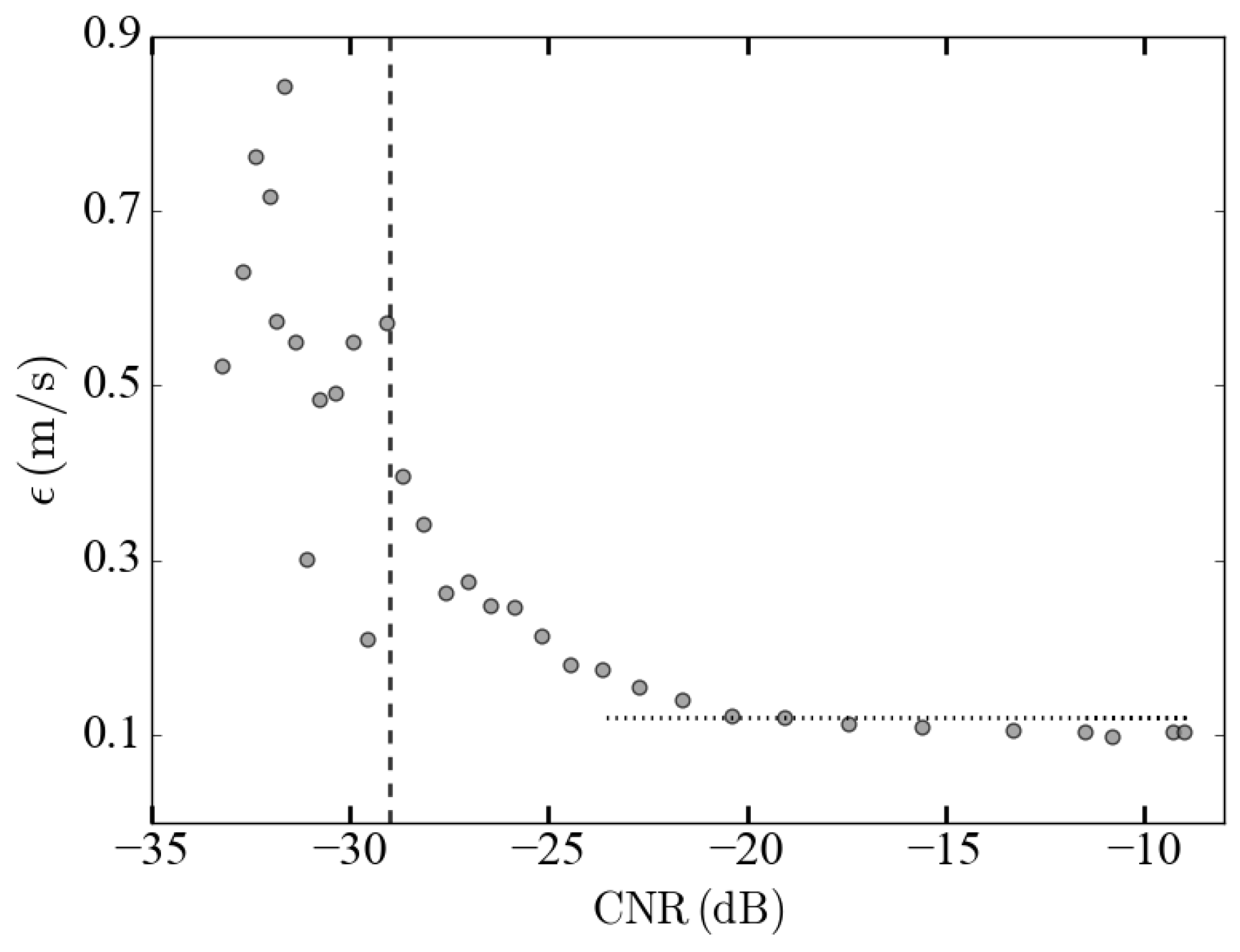
References
- Darby, L.S.; Allwine, K.J.; Banta, R.M. Nocturnal low-level jet in a mountain basin complex. Part II: Transport and diffusion of tracer under stable conditions. J. Appl. Meteorol. Climatol. 2006, 45, 740–753. [Google Scholar] [CrossRef]
- Gohm, A.; Harnisch, F.; Fix, A. Boundary Layer Structure in the Inn Valley during High Air Pollution (INNAP). In Proceedings of the 12th Conference on Mountain Meteorology, Santa Fe, NM, USA, 28 August– 1 September 2006; Available online: http://ams.confex.com/ams/pdfpapers/114458.pdf (accessed on 2 November 2017).
- Silcox, G.D.; Kelly, K.E.; Crosman, E.T.; Whiteman, C.D.; Allen, B.L. Wintertime PM2.5 concentrations during persistent, multi-day cold-air pools in a mountain valley. Atmos. Environ. 2012, 46, 17–24. [Google Scholar] [CrossRef]
- Rendón, A.M.; Salazar, J.F.; Palacio, C.A.; Wirth, V.; Brötz, B. Effects of urbanization on the temperature inversion breakup in a mountain valley with implications for air quality. J. Appl. Meteorol. Climatol. 2014, 53, 840–858. [Google Scholar] [CrossRef]
- Pope, C.A.; Dockery, D.W. Acute health effects of PM10 pollution on symptomatic and asymptomatic children. Am. Rev. Respir. Dis. 1992, 145, 1123–1128. [Google Scholar] [CrossRef] [PubMed]
- Laden, F.; Schwartz, J.; Speizer, F.E.; Dockery, D.W. Reduction in fine particulate air pollution and mortality: Extended follow-up of the Harvard Six Cities study. Am. J. Respir. Crit. Care Med. 2006, 173, 667–672. [Google Scholar] [CrossRef] [PubMed]
- Weinmayr, G.; Romeo, E.; De Sario, M.; Weiland, S.K.; Forastiere, F. Short-term effects of PM10 and NO2 on respiratory health among children with asthma or asthma-like symptoms: A systematic review and meta-analysis. Environ. Health Perspect. 2010, 118, 449. [Google Scholar] [CrossRef] [PubMed]
- Price, J.; Vosper, S.; Brown, A.; Ross, A.; Clark, P.; Davies, F.; Horlacher, V.; Claxton, B.; McGregor, J.; Hoare, J.; et al. COLPEX: Field and numerical studies over a region of small hills. Bull. Am. Meteorol. Soc. 2011, 92, 1636–1650. [Google Scholar] [CrossRef]
- Largeron, Y.; Staquet, C. Persistent inversion dynamics and wintertime PM10 air pollution in Alpine valleys. Atmos. Environ. 2016, 135, 92–108. [Google Scholar] [CrossRef]
- Whiteman, C.D. Mountain Meteorology: Fundamentals and Applications; Oxford University Press: Oxford, UK, 2000. [Google Scholar]
- Wagner, A. Theorie und Beobachtung der periodischen Gebirgswinde. [Theory and observation of periodic mountain winds]. Gerlands Beiträge zur Geophysik (Leipzig) 1938, 52, 408–449. [Google Scholar]
- Ekhart, E. De la structure thermique de l’atmosphère dans la montagne [On the thermal structure of the mountain atmosphere]. La Meteorologie 1948, 4, 3–6. [Google Scholar]
- Lehner, M.; Gohm, A. Idealised simulations of daytime pollution transport in a steep valley and its sensitivity to thermal stratification and surface albedo. Bound. Layer Meteorol. 2010, 134, 327–351. [Google Scholar] [CrossRef]
- Banta, R.; Olivier, L.; Neff, W.; Levinson, D.; Ruffieux, D. Influence of canyon-induced flows on flow and dispersion over adjacent plains. Theor. Appl. Climatol. 1995, 52, 27–42. [Google Scholar] [CrossRef]
- Colette, A.; Chow, F.K.; Street, R.L. A numerical study of inversion-layer breakup and the effects of topographic shading in idealized valleys. J. Appl. Meteorol. 2003, 42, 1255–1272. [Google Scholar] [CrossRef]
- Wagner, J.; Gohm, A.; Rotach, M. Influence of along-valley terrain heterogeneity on exchange processes over idealized valleys. Atmos. Chem. Phys. 2015, 15, 6589–6603. [Google Scholar] [CrossRef]
- Whiteman, C.D. Observations of thermally developed wind systems in mountainous terrain. In Atmospheric Processes Over Complex Terrain; Springer: Berlin, Germany, 1990; pp. 5–42. [Google Scholar]
- Blumen, W. Atmospheric Processes over Complex Terrain; Springer: Berlin, Germany, 1990; Volume 23. [Google Scholar]
- Salmond, J.; McKendry, I. A review of turbulence in the very stable nocturnal boundary layer and its implications for air quality. Prog. Phys. Geogr. 2005, 29, 171–188. [Google Scholar] [CrossRef]
- Largeron, Y. Dynamique de la Couche Limite Atmosphérique Stable en Relief Complexe. Application aux Épisodes de Pollution Particulaire des Vallées Alpines. Ph.D. Thesis, Université de Grenoble, Grenoble, France, 2010. [Google Scholar]
- Rucker, M.; Banta, R.M.; Steyn, D.G. Along-valley structure of daytime thermally driven flows in the Wipp Valley. J. Appl. Meteorol. Climatol. 2008, 47, 733–751. [Google Scholar] [CrossRef]
- Giovannini, L.; Laiti, L.; Seraphin, S.; Zardi, D. The thermally driven diurnal wind system of the Adige Valley in the Italian Alps. Q. J. R. Meteorol. Soc. 2017, 143, 2389–2402. [Google Scholar] [CrossRef]
- Doran, J.; Fast, J.D.; Horel, J. The VTMX 2000 campaign. Bull. Am. Meteorol. Soc. 2002, 83, 537–551. [Google Scholar] [CrossRef]
- Banta, R.M.; Darby, L.S.; Fast, J.D.; Pinto, J.O.; Whiteman, C.D.; Shaw, W.J.; Orr, B.W. Nocturnal low-level jet in a mountain basin complex. Part I: Evolution and effects on local flows. J. Appl. Meteorol. 2004, 43, 1348–1365. [Google Scholar] [CrossRef]
- Gohm, A.; Harnisch, F.; Vergeiner, J.; Obleitner, F.; Schnitzhofer, R.; Hansel, A.; Fix, A.; Neininger, B.; Emeis, S.; Schäfer, K. Air pollution transport in an Alpine valley: Results from airborne and ground-based observations. Bound. Layer Meteorol. 2009, 131, 441–463. [Google Scholar] [CrossRef] [Green Version]
- Harnisch, F.; Gohm, A.; Fix, A.; Schnitzhofer, R.; Hansel, A.; Neininger, B. Spatial distribution of aerosols in the Inn Valley atmosphere during wintertime. Meteorol. Atmos. Phys. 2009, 103, 223–235. [Google Scholar] [CrossRef] [Green Version]
- Duine, G.J.; Hedde, T.; Roubin, P.; Durand, P.; Lothon, M.; Lohou, F.; Augustin, P.; Fourmentin, M. Characterization of valley flows within two confluent valleys under stable conditions: Observations from the KASCADE field experiment. Q. J. R. Meteorol. Soc. 2017, 143, 1886–1902. [Google Scholar] [CrossRef]
- Atmo Auvergne-Rhone-Alpes. Available online: www.atmo-auvergnerhonealpes.fr (accessed on 12 December 2017).
- Paci, A.; Staquet, C.; Allard, J.; Barral, H.; Canut, G.; Cohard, J.M.; Jaffrezo, J.L.; Martinet, P.; Sabatier, T.; Troude, F.; et al. The Passy-2015 field experiment: Atmospheric dynamics and air quality. Poll. Atmos. 2016, 231–232. Available online: http://lodel.irevues.inist.fr/pollution-atmospherique/index.php?id=5903&format=print (accessed on 10 October 2017).
- Chemel, C.; Arduini, G.; Staquet, C.; Largeron, Y.; Legain, D.; Tzanos, D.; Paci, A. Valley heat deficit as a bulk measure of wintertime particulate air pollution in the Arve River Valley. Atmos. Environ. 2016, 128, 208–215. [Google Scholar] [CrossRef] [Green Version]
- PPA. Plan de Protection de l’Atmosphere (PPA) de la vallée de l’Arve. Available online: http://www.hautesavoie.gouv.fr/content/download/15754/92617/file/ppa_20120305.pdf (accessed on 12 December 2017).
- PPA. Le portail national de la connaissance du territoire mis en oeuvre par l’IGN. Available online: www.geoportail.gouv.fr (accessed on 1 June 2016).
- Air-Rhône-Alpes. Bilan de la Qualité de l’air 2015-Diagnostic Annuel; Technical Report; Air Rhône-Alpes: Lyon, France, 2015. [Google Scholar]
- Triantafyllou, A. PM10 pollution episodes as a function of synoptic climatology in a mountainous industrial area. Environ. Pollut. 2001, 112, 491–500. [Google Scholar] [CrossRef]
- Pernigotti, D.; Rossa, A.M.; Ferrario, M.E.; Sansone, M.; Benassi, A. Influence of ABL stability on the diurnal cycle of PM10 concentration: Illustration of the potential of the new Veneto network of MW-radiometers and SODAR. Meteorol. Z. 2007, 16, 505–511. [Google Scholar] [CrossRef] [PubMed]
- Schäfer, K.; Vergeiner, J.; Emeis, S.; Wittig, J.; Hoffmann, M.; Obleitner, F.; Suppan, P. Atmospheric influences and local variability of air pollution close to a motorway in an Alpine valley during winter. Meteorol. Z. 2008, 17, 297–309. [Google Scholar] [CrossRef]
- Largeron, Y.; Paci, A.; Rodier, Q.; Vionnet, V.; Legain, D. Persistent temperature inversions in the Chamonix-Mont-Blanc valley during IOP1 of the Passy-2015 field experiment. J. Appl. Meteorol. Climatol. submitted.
- Legain, D.; Bousquet, O.; Douffet, T.; Tzanos, D.; Moulin, E.; Barrié, J.; Renard, J.B. High-frequency boundary layer profiling with reusable radiosondes. Atmos. Meas. Tech. 2013, 6, 2195–2205. [Google Scholar] [CrossRef] [Green Version]
- Leosphere. WINDCUBE Product Information; Technical Report; Leosphere: Orsay, France, 2015. [Google Scholar]
- Fujii, T.; Fukuchi, T. Laser Remote Sensing; CRC Press: Boca Raton, FL, USA, 2005. [Google Scholar]
- Chouza, F.; Reitebuch, O.; Groß, S.; Rahm, S.; Freudenthaler, V.; Toledano, C.; Weinzierl, B. Retrieval of aerosol backscatter and extinction from airborne coherent Doppler wind lidar measurements. Atmos. Meas. Tech. 2015, 8, 2909–2926. [Google Scholar] [CrossRef]
- Courtney, M.; Wagner, R.; Lindelöw, P. Testing and Comparison of Lidars for Profile and Turbulence Measurements in Wind Energy; IOP Conference Series: Earth and Environmental Science; IOP Publishing: Bristol, UK, 2008; Volume 1, p. 012021. [Google Scholar]
- Kumer, V.M.; Reuder, J.; Furevik, B.R. A comparison of LiDAR and radiosonde wind measurements. Energy Procedia 2014, 53, 214–220. [Google Scholar] [CrossRef] [Green Version]
- Largeron, Y.; Staquet, C.; Chemel, C. Characterization of oscillatory motions in the stable atmosphere of a deep valley. Bound. Layer Meteorol. 2013, 148, 439–454. [Google Scholar] [CrossRef] [Green Version]
- Porch, W.M.; Fritz, R.B.; Coulter, R.L.; Gudiksen, P.H. Tributary, valley and sidewall air flow interactions in a deep valley. J. Appl. Meteorol. 1989, 28, 578–589. [Google Scholar] [CrossRef]
- McNider, R.T. A note on velocity fluctuations in drainage flows. J. Atmos. Sci. 1982, 39, 1658–1660. [Google Scholar] [CrossRef]
- Vergeiner, I.; Dreiseitl, E. Valley winds and slope winds—Observations and elementary thoughts. Meteorol. Atmos. Phys. 1987, 36, 264–286. [Google Scholar] [CrossRef]
- Etling, D. On plume meandering under stable stratification. Atmos. Environ. Part A Gen. Top. 1990, 24, 1979–1985. [Google Scholar] [CrossRef]
- Weigel, A.P.; Rotach, M.W. Flow structure and turbulence characteristics of the daytime atmosphere in a steep and narrow Alpine valley. Q. J. R. Meteorol. Soc. 2004, 130, 2605–2627. [Google Scholar] [CrossRef]
- Frehlich, R.; Cornman, L. Estimating spatial velocity statistics with coherent Doppler lidar. J. Atmos. Ocean. Technol. 2002, 19, 355–366. [Google Scholar] [CrossRef]
- Dabas, A. Semiempirical model for the reliability of a matched filter frequency estimator for Doppler lidar. J. Atmos. Ocean. Technol. 1999, 16, 19–28. [Google Scholar] [CrossRef]
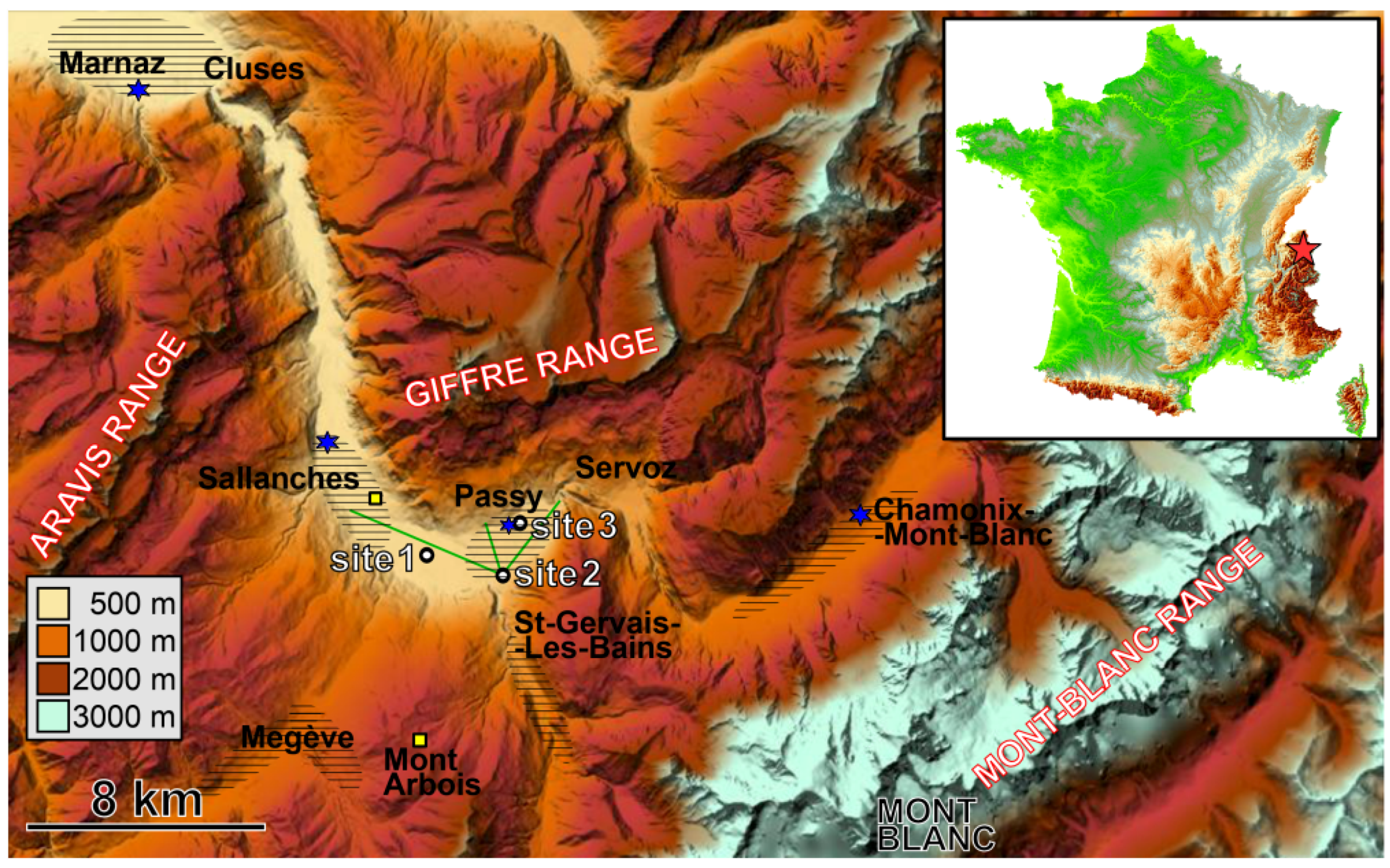
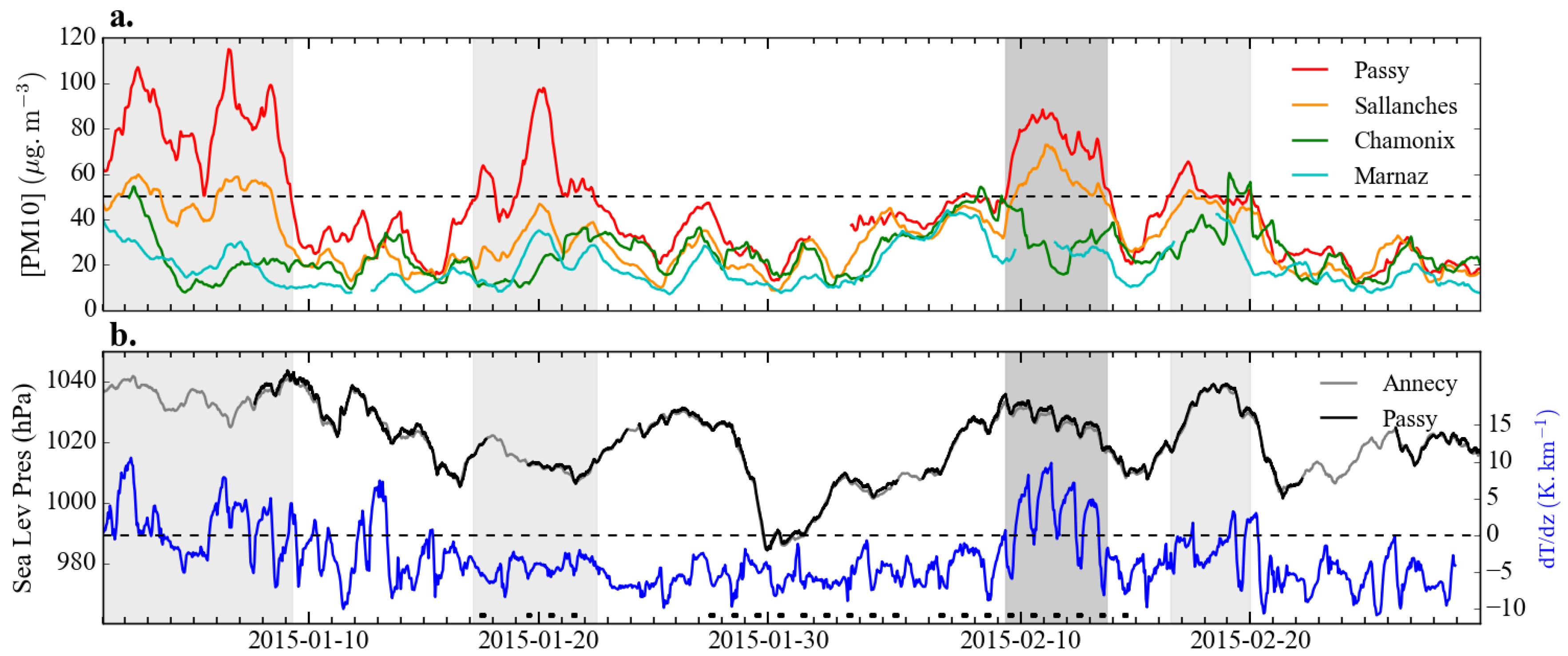

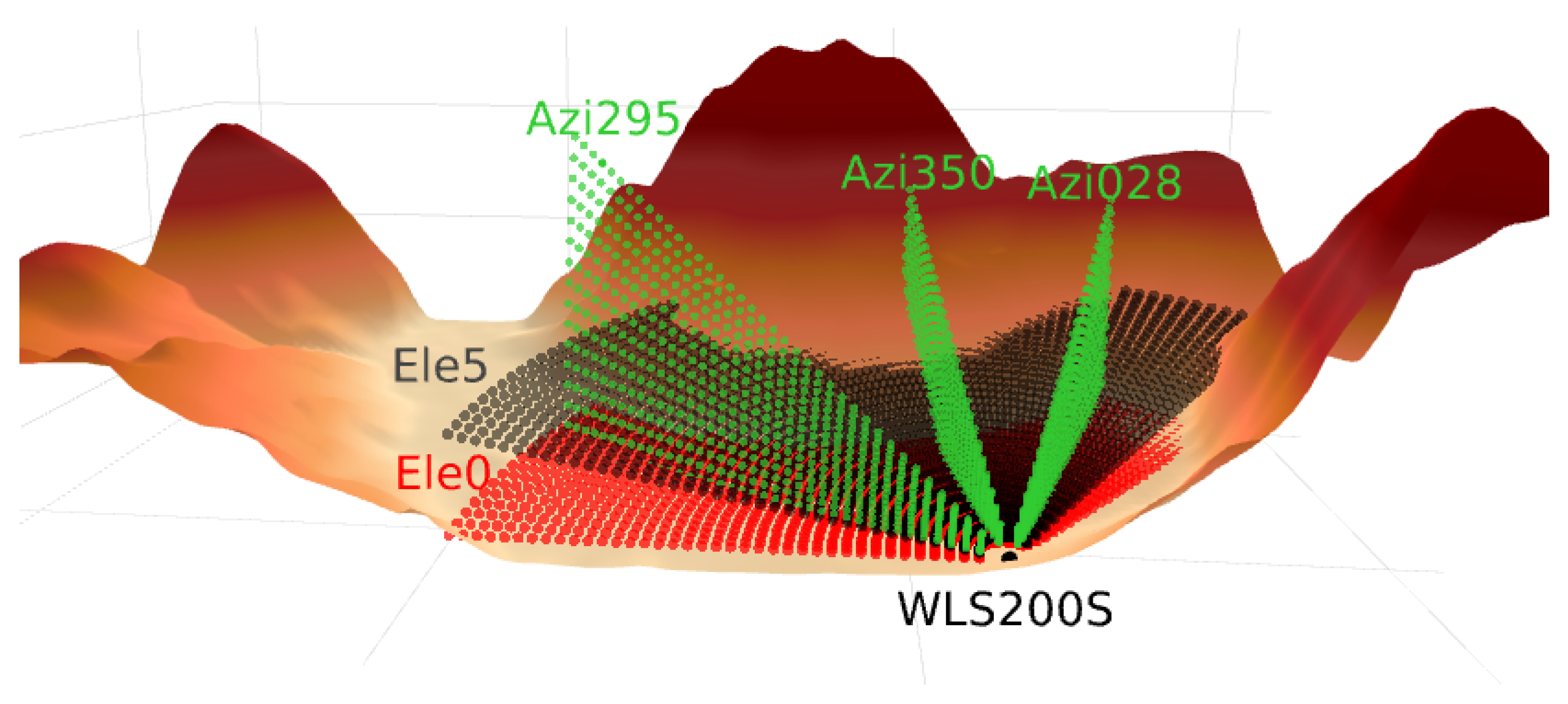
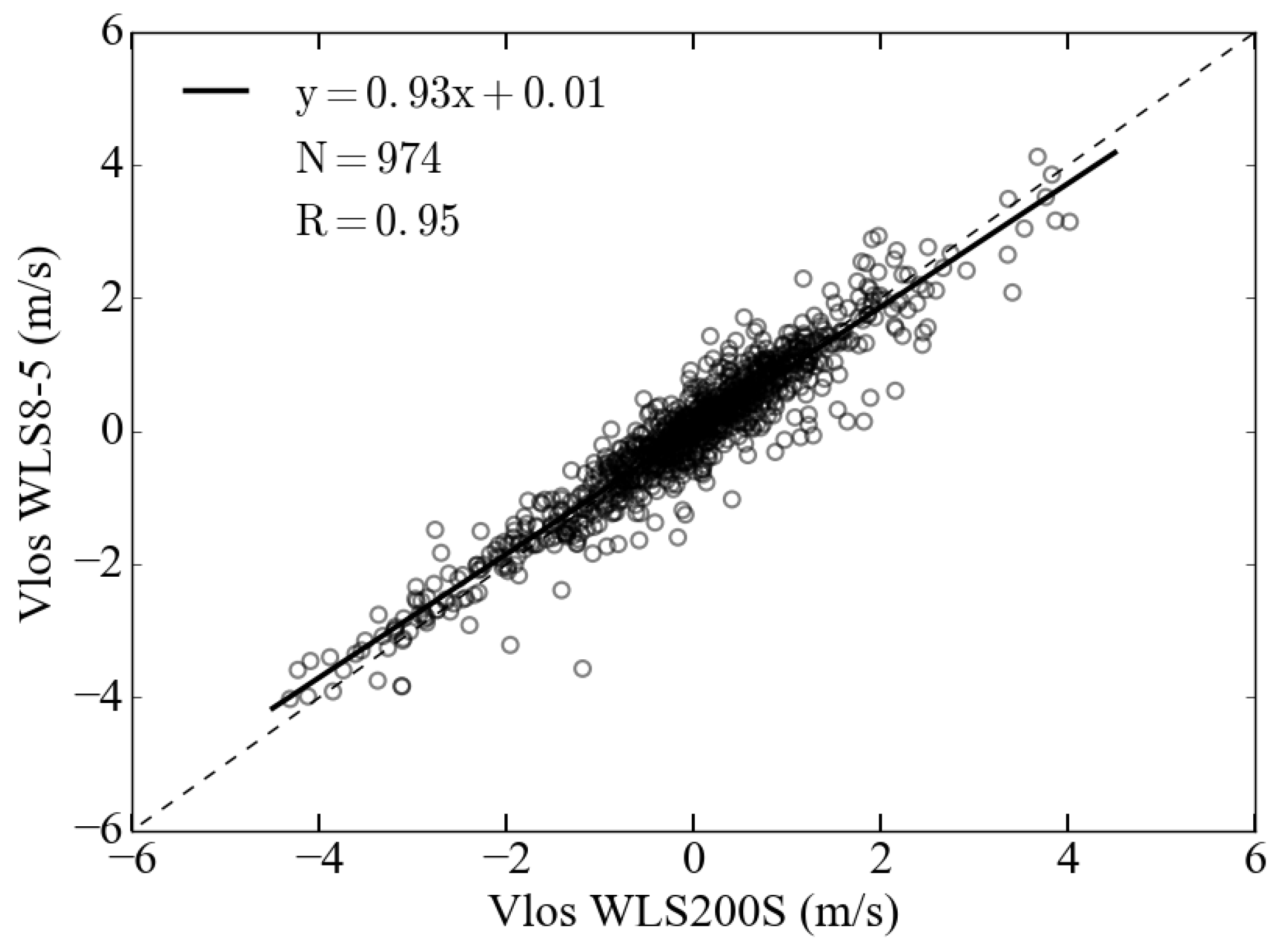


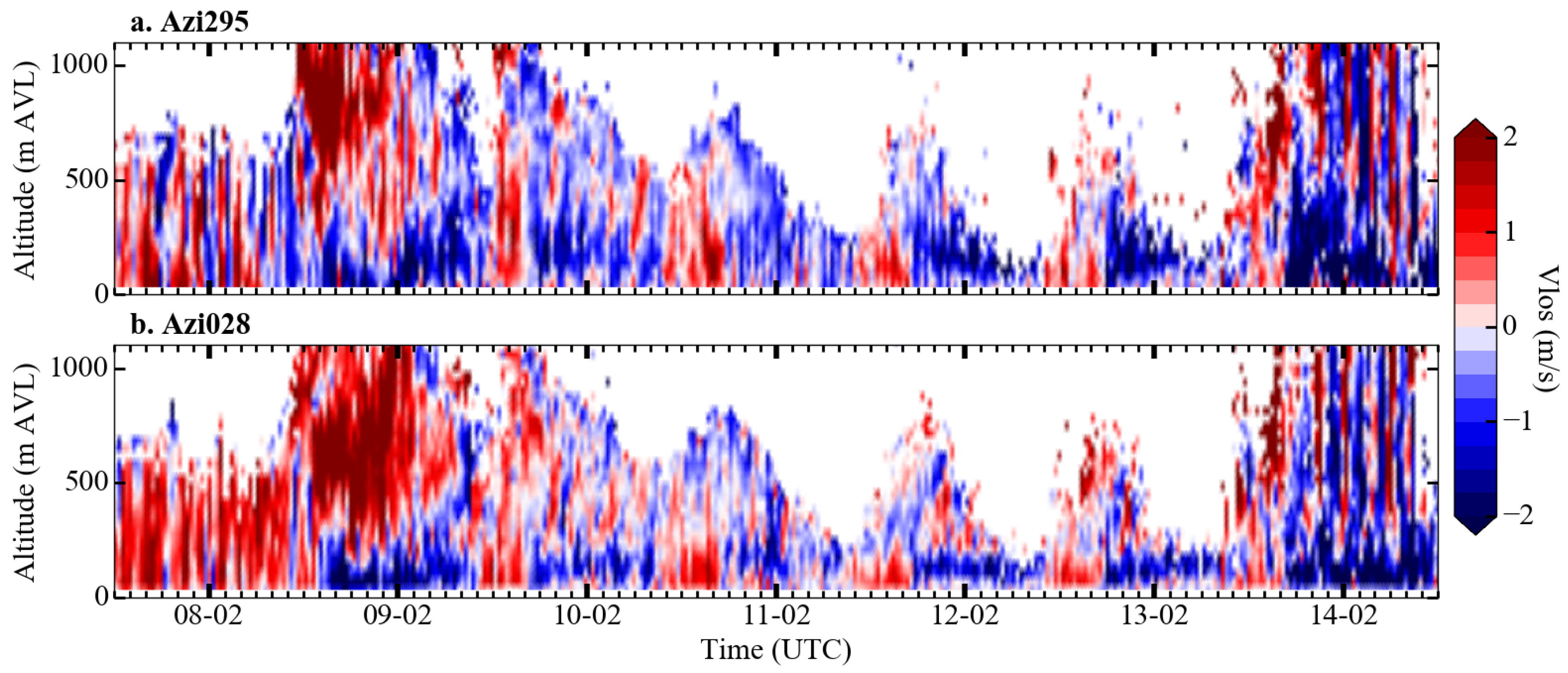
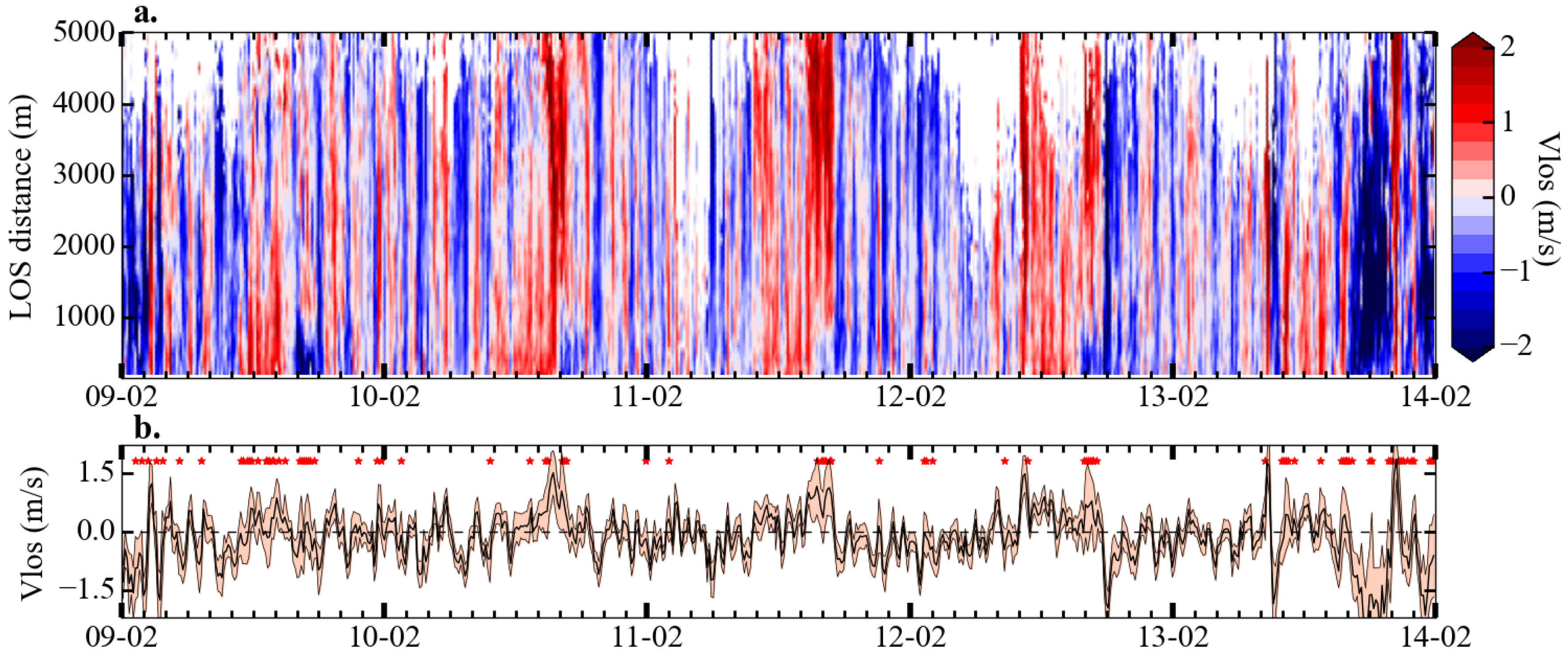

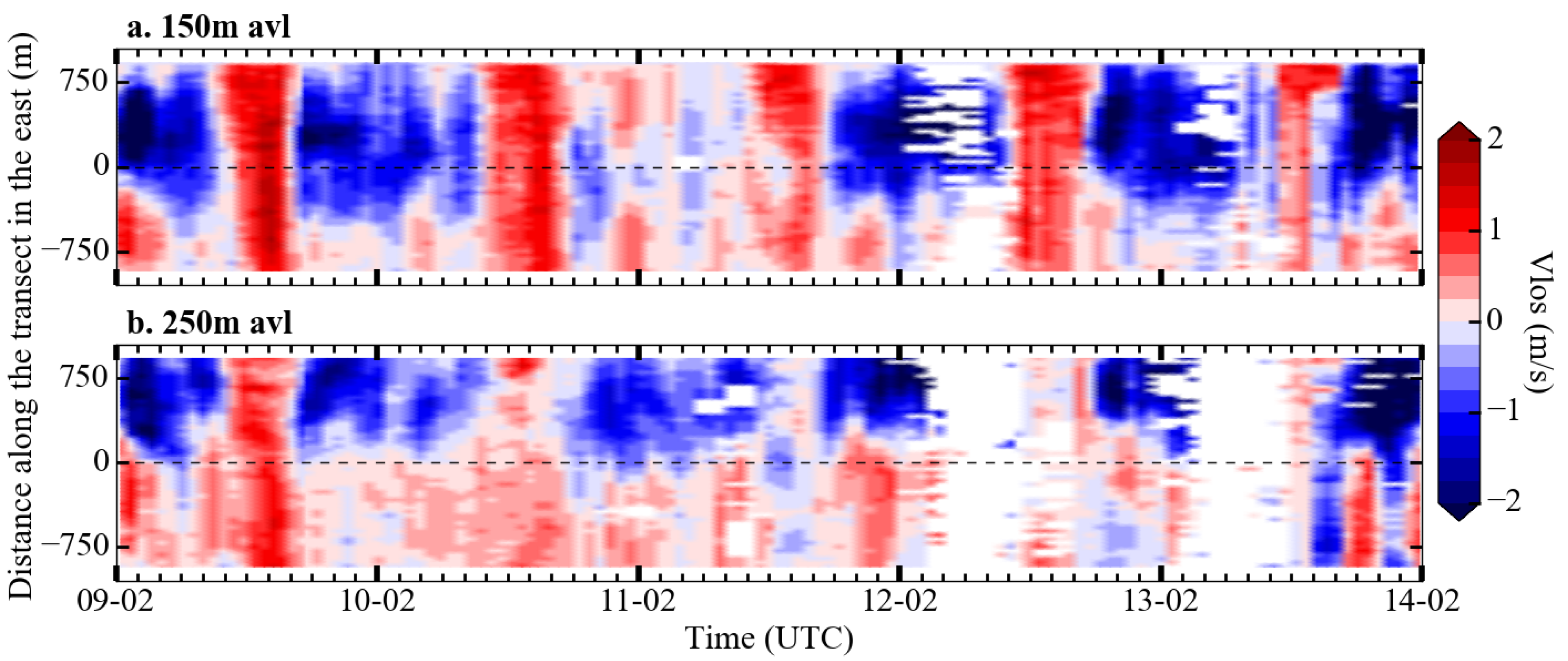
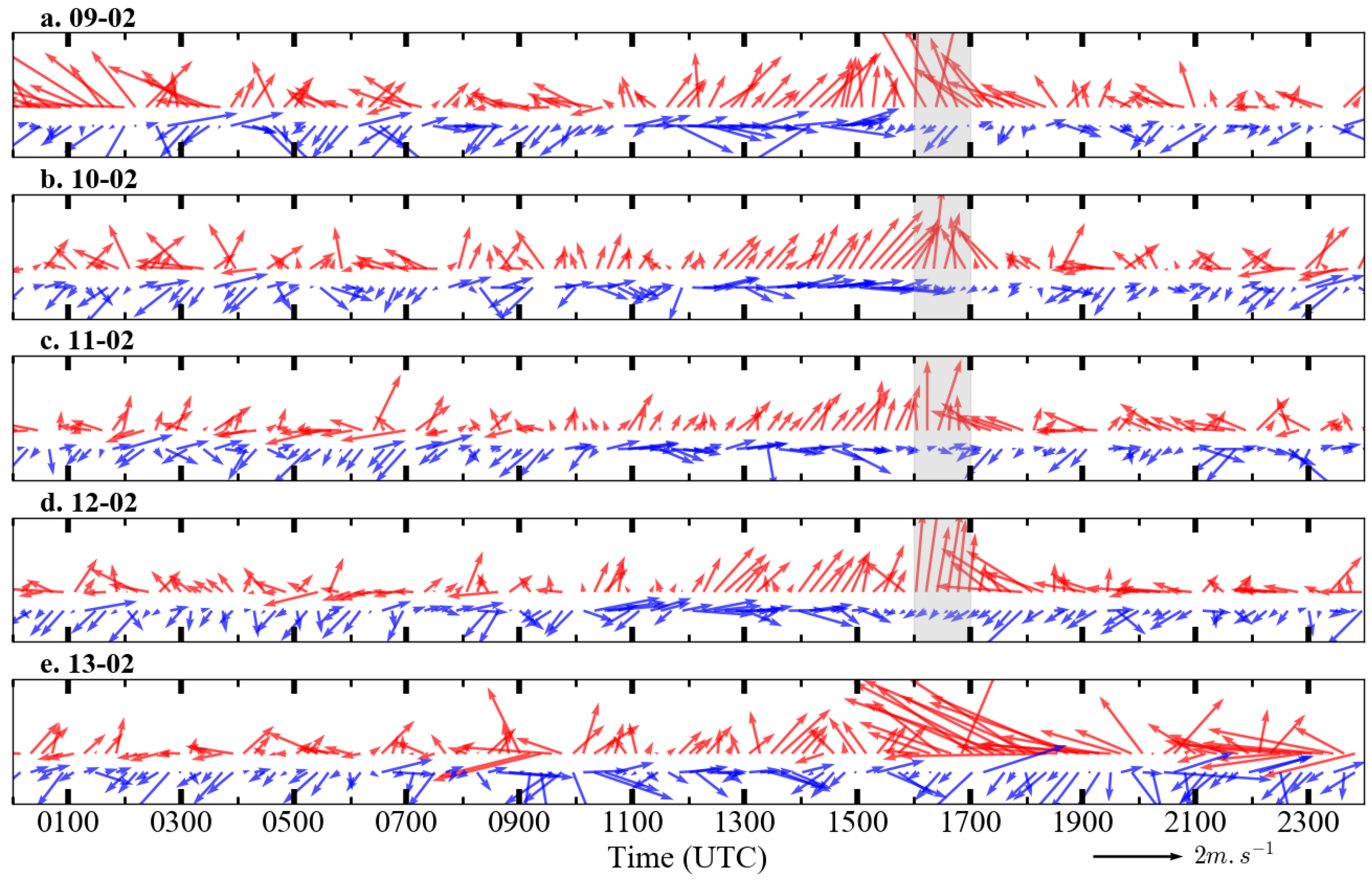
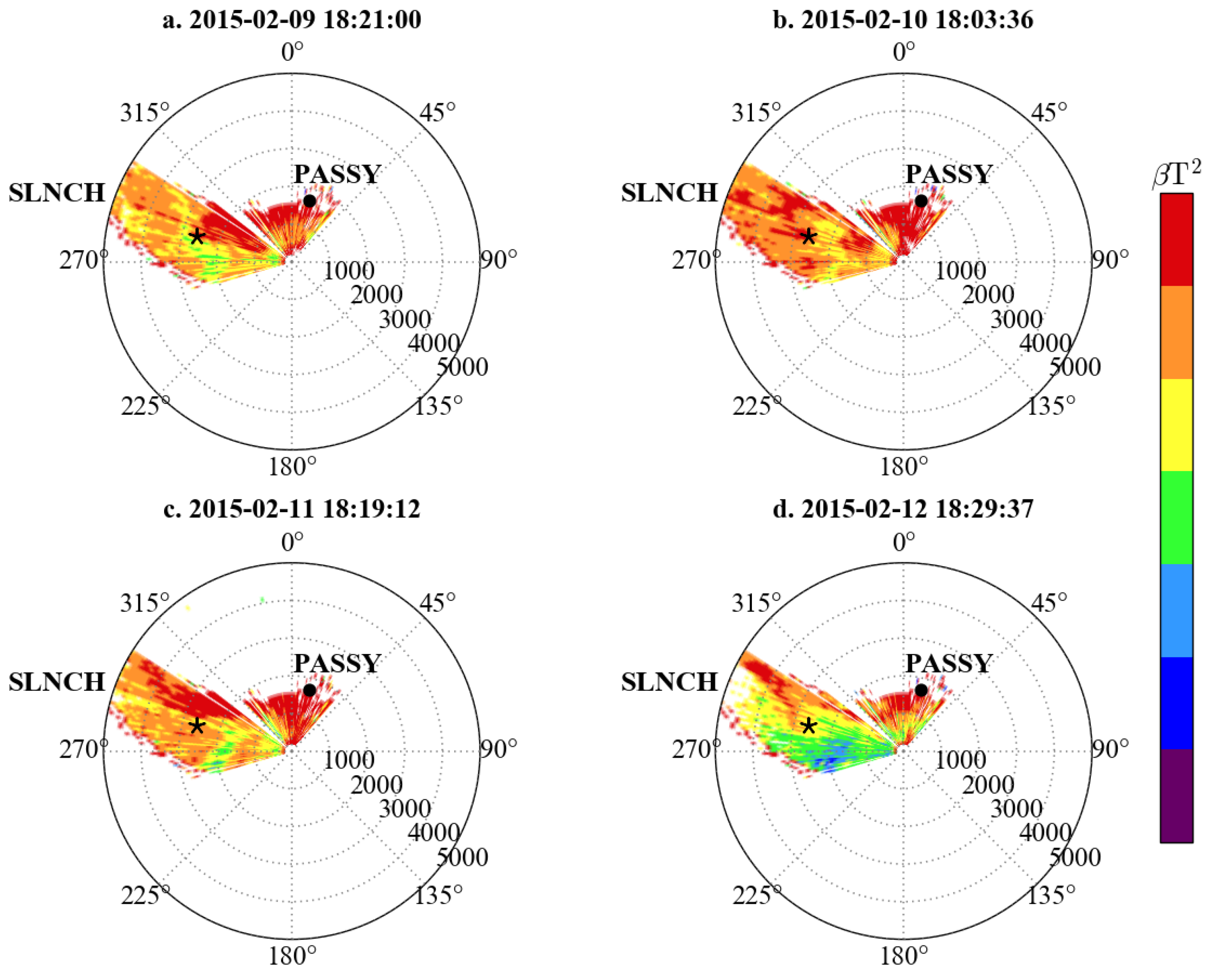
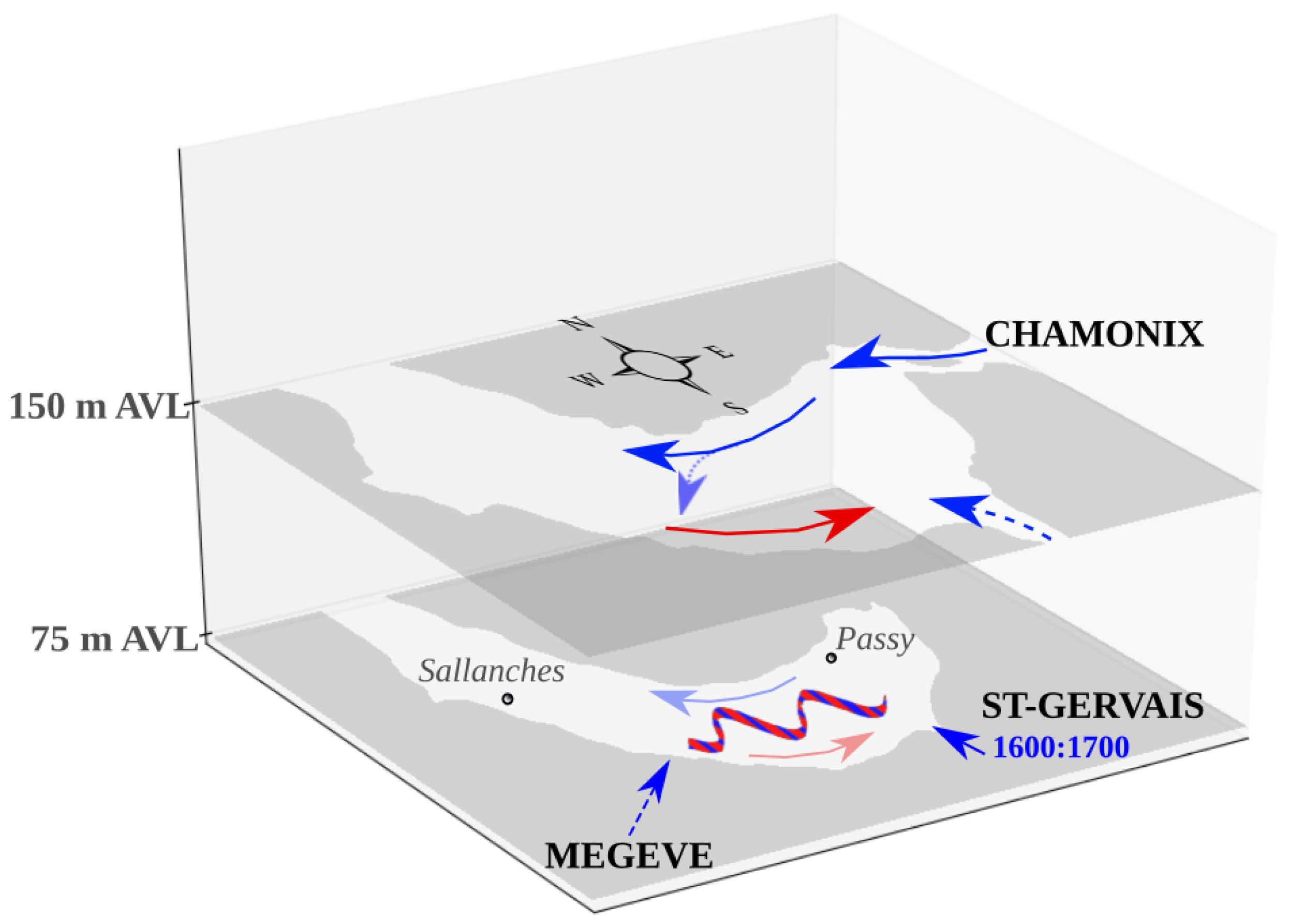
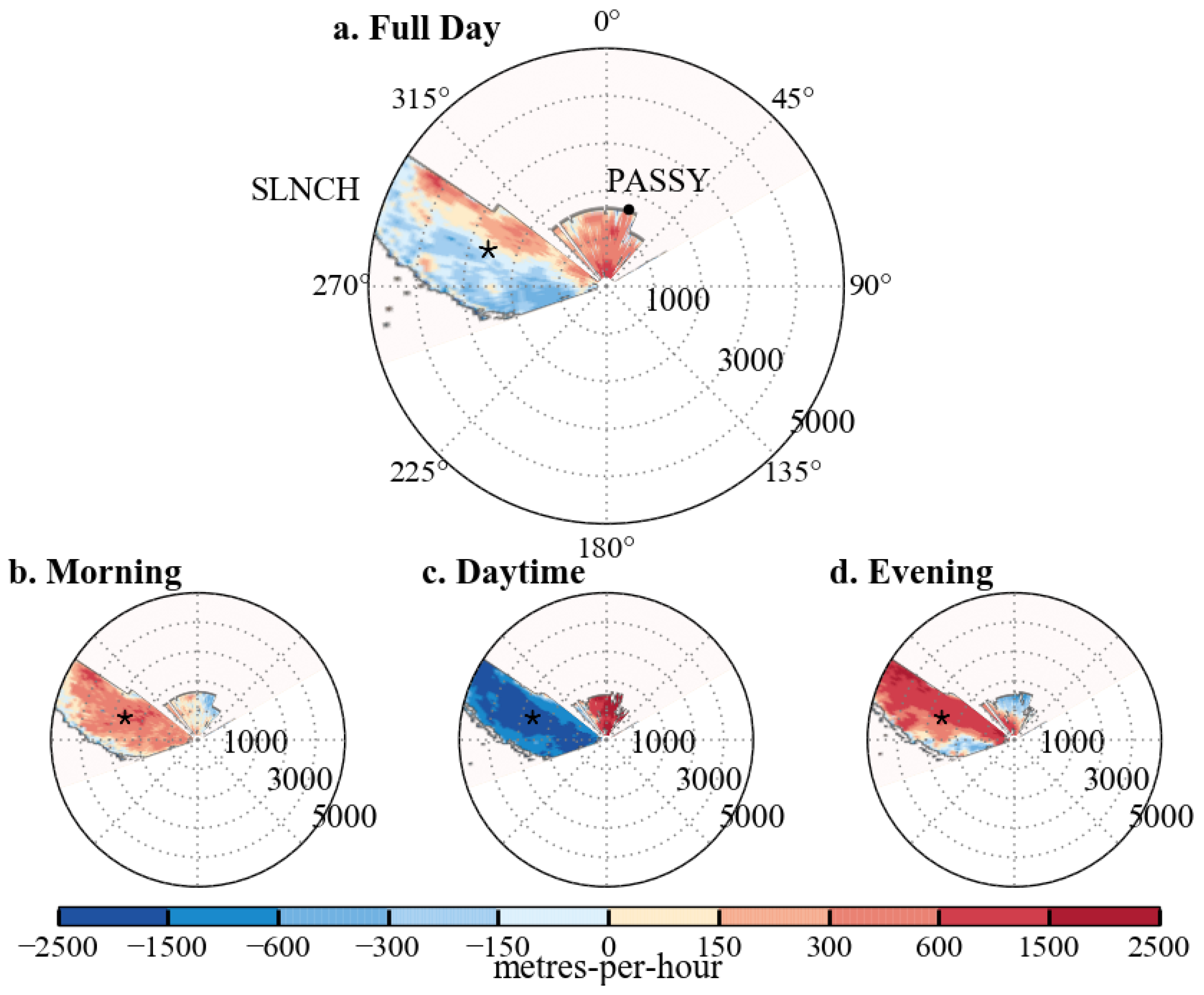
| Episode | Time | Max (Day of the Max/Epis. Duration) | Max (Day of the Max/Epis. Duration) | Max (Day of the Max/Epis. Duration) |
|---|---|---|---|---|
| 1 | 1–8 January | 115 () | 60 () | 60 () |
| 2 | 17–22 January | 98 () | 48 () | 37 () |
| 3 | 9–14 February | 88 () | 73 () | 48 () |
| 4 | 16–20 February | 66 () | 54 () | 61 () |
| Site | Coord. (N, E) | Elev. (m ASL) | Elev. (m AVL) | Sensor | Variables | Meas. Geom. | Meas. Available Every |
|---|---|---|---|---|---|---|---|
| 1 | 45.9140 6.6741 | 560 | 0 | Profiler Doppler Wind Lidar WLS8-5 (Leosphere) | DD, FF, CNR | Z | 3 s |
| Radiosonde RS92-SGP (Vasaila) | T, RH, DD, FF | Z | 3 h | ||||
| Ceilometer CT25K (Vaisala) | Cloud layer bottom | Z | 15 s | ||||
| Net Radiometer CNR1 (Kipp and Zonen) | , | L | 30 min | ||||
| Present Weather Detector PWD22 (Vaisala) | Visibility | L | 14 s | ||||
| Barometer PTB210 (Vaisala) | P | L | 1 min | ||||
| 2 | 45.9080 6.7072 | 602 | 42 | Scanning Doppler Wind Lidar WLS200S (Leosphere) | , CNR | Z H | 30 min 10 min |
| 3 | 45.9235 6.7136 | 588 | 28 | TEOM-FDMS (Thermo Fisher Sci.) | PM10 | L | 1 h |
| WLS200S | WLS8-5 | |
|---|---|---|
| Wavelength (m) | ||
| Accumulation time (sec) | 1 | 3 |
| Nb. Pulses averaged | ||
| Scan speed (deg·s) | 1 | - |
| Range resolution (m) | 100 | 20 |
| Range gates | 59 | 24 |
| Azimuth Range (°relative to north) | 250 to 60 | - |
| Elevation Range (°relative to Horiz.) | 0 to 90 | - |
| Scan cone angle (°) | - | |
| Speed accuracy (from manufacturer) (m·s) | ||
| Direction accuracy (from manufacturer) (°) | - | 2 |
© 2018 by the authors. Licensee MDPI, Basel, Switzerland. This article is an open access article distributed under the terms and conditions of the Creative Commons Attribution (CC BY) license (http://creativecommons.org/licenses/by/4.0/).
Share and Cite
Sabatier, T.; Paci, A.; Canut, G.; Largeron, Y.; Dabas, A.; Donier, J.-M.; Douffet, T. Wintertime Local Wind Dynamics from Scanning Doppler Lidar and Air Quality in the Arve River Valley. Atmosphere 2018, 9, 118. https://doi.org/10.3390/atmos9040118
Sabatier T, Paci A, Canut G, Largeron Y, Dabas A, Donier J-M, Douffet T. Wintertime Local Wind Dynamics from Scanning Doppler Lidar and Air Quality in the Arve River Valley. Atmosphere. 2018; 9(4):118. https://doi.org/10.3390/atmos9040118
Chicago/Turabian StyleSabatier, Tiphaine, Alexandre Paci, Guylaine Canut, Yann Largeron, Alain Dabas, Jean-Marie Donier, and Thierry Douffet. 2018. "Wintertime Local Wind Dynamics from Scanning Doppler Lidar and Air Quality in the Arve River Valley" Atmosphere 9, no. 4: 118. https://doi.org/10.3390/atmos9040118





